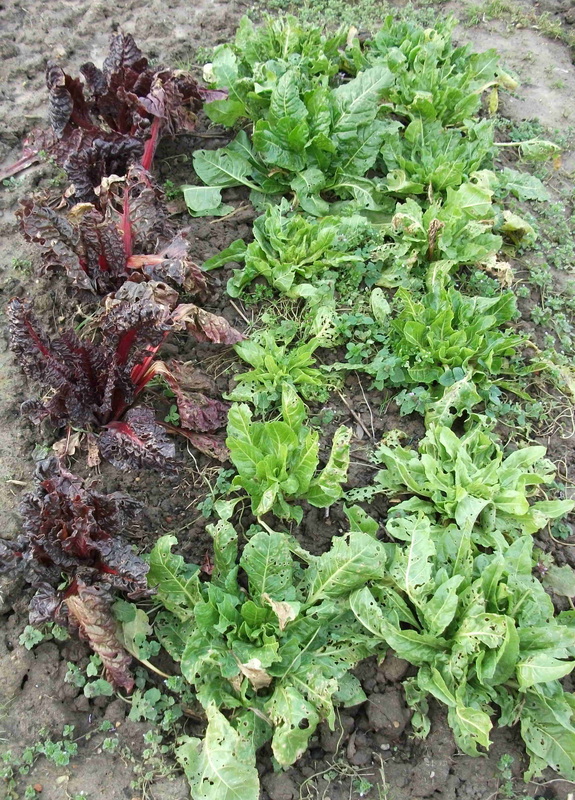Spinach, Chard and Good King Henry
These leafy vegetables are all closely related; they are cousins of Dock and Sorrel (both of which are also edible). Rich in iron and vitamin C, they are expensive to buy in the shops and well worth growing.
However, spinach is notorious for 'bolting' (producing unwanted flowering shoots), especially in the hot dry summers which are more common than not in Kent. If you are determined to grow it in Ashford, give it well-prepared, well-fertilised soil and water it like crazy.
There are other options, the most popular of which is "Perpetual Spinach". Perpetual spinach and Chard are just different strains of the same plant. Chard is valued for its thick fleshy midribs, while Perpetual Spinach has more leaf area and thinner stems. You pays yer money and you takes yer pick. This plant is one of the easiest to grow and a very valuable "hungry gap" crop. If you've just taken on an allotment, sow a short row in the first bit of ground you clear and you'll have "baby spinach" to pick before you know it.
It can be sown almost all the year round. A spring sowing will quickly yield you leaves as you thin the row; the mature plants will keep cropping right through the following winter. An autumn sowing will make good use of a piece of ground that would otherwise be sitting empty: you can rip it out ready to prepare the soil for cabbages or cauliflowers in early summer.
Perpetual Spinach has another virtue, which few gardeners realise. When ordinary spinach starts to bolt, that's the end of the crop. When Perpetual Spinach sends up a flowering shoot, the little leaves it produces all up the stem are the tenderest and tastiest of all. Cut the stem, and strip off the leaves; the plant will soon produce another stem for you to use. When the whole plant gets a bit shabby looking, cut off at ground level and it will sprout again from the root. The big fleshy roots may look intimidatingly permanent, but in fact when you want to clear the ground they come out easily.
It can be sown almost all the year round. A spring sowing will quickly yield you leaves as you thin the row; the mature plants will keep cropping right through the following winter. An autumn sowing will make good use of a piece of ground that would otherwise be sitting empty: you can rip it out ready to prepare the soil for cabbages or cauliflowers in early summer.
Perpetual Spinach has another virtue, which few gardeners realise. When ordinary spinach starts to bolt, that's the end of the crop. When Perpetual Spinach sends up a flowering shoot, the little leaves it produces all up the stem are the tenderest and tastiest of all. Cut the stem, and strip off the leaves; the plant will soon produce another stem for you to use. When the whole plant gets a bit shabby looking, cut off at ground level and it will sprout again from the root. The big fleshy roots may look intimidatingly permanent, but in fact when you want to clear the ground they come out easily.
|
Chard is more fashionable, and you'll find many recipes on the internet. Most these days pick the leaves quite small and use the whole leaf; older recipes separate the stem and the green part and treat them separately. When cooking chard, you need to know that it needs to be in a little liquid. If you try to steam the stems they have a nasty habit of discolouring with a black tinge. Bleeugh!
Chard is available in red selections, and as "Rainbow Chard" with stems in every shade from yellow through to deep red. Very pretty in the garden, but careful cooking is needed to keep the colour fresh. Ruby Chard and Perpetual Spinach (left) thriving on neglect in appalling weather conditions. |
If you're going to grow either Perpetual Spinach or Chard as a catch crop, or for seedling leaves, you'll need a lot of seed. Set a plant aside in a quiet corner where it can be allowed to ripen its seeds and you'll soon have a generous supply. They will last for several years if stored carefully.
Good King Henry is also known as "Lincolnshire Spinach". It is much praised in blogs by self-sufficiency enthusiasts, and it is certainly rich in nourishment. The young shoots are steamed and eaten like asparagus (an instruction one finds in a lot of books on unusual vegetables) - sadly, it has none of the delectable flavour of asparagus. It is, despite that, a tasty alternative and especially good for one of the modern "pocket handkerchief" size allotments where every square foot counts.
Seed of Good King Henry is widely available, but germination can be tricky. It comes much better from fresh seed and will, if allowed, seed itself. If anyone has a hankering to try it, contact the website compiler on [email protected], as some spare plants can usually be found at any time of year.
Seed of Good King Henry is widely available, but germination can be tricky. It comes much better from fresh seed and will, if allowed, seed itself. If anyone has a hankering to try it, contact the website compiler on [email protected], as some spare plants can usually be found at any time of year.
New Zealand Spinach is often recommended as an alternative to spinach which is less inclined to bolt. However, the leaves are small and the flavour insipid; the texture is also quite different to spinach and many gardeners do not find it an acceptable substitute.


